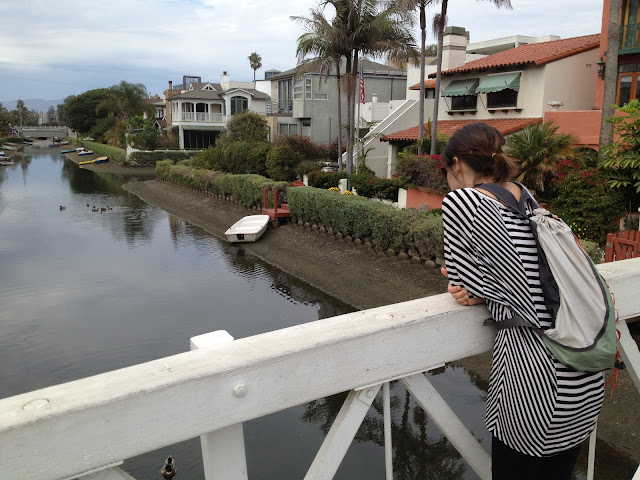If you are visiting Los Angeles, it is well work the time to spend a day in Santa Monica and Venice. My wife Madelyn and I rented bikes on the famous Santa Monica Pier and made it to Venice in about 45 leisurely minutes. As often with any travel experience, the journey is often the best part.
(Note: Parking in Santa Monica is probably going to be your first concern. Turn onto the pier to find the cheapest and most abundant parking)
The Santa Monica Pier is a great place to wander. A small amusement park sits above the Pacific. The Ferris Wheel gives you a great view of Malibu to the north, Santa Monica to the west, and Venice Beach to the South. It's well worth the price.
 |
| Madelyn on the Ferris Wheel with the Pacific Ocean in the background |
 |
| The Roller Coaster on Santa Monica Pier. Not much of a thrill ride, but it is fun to ride a coaster above the Pacific Ocean |
After hanging on the Pier for a while, we rented bikes and headed south toward Venice Beach. The bike trail is wide and straight. An easy ride for all ages.
One of the first stops is the Original Muscle Beach. Today, most of the workout buffs are in Venice Beach. This is a nice place to stop and have some fun on the rings and other various apparatus.
Notice how large the beach is in Santa Monica. We were there in early September. With school back in session, there weren't very many people on the beach.
A little cafe about halfway to Venice where we stopped for a cold drink
Arriving in Venice, the sidewalk gets a little more crowded. This is the famed Venice Boardwalk. Plenty of places to stop, walk and wander. One of the benefits of riding your bike here, is that you don't need to find a place to park
The Venice skateboard park, part of a large park on Venice Beach.
It's a little hard to find, but well worth the time to search and discover the remaining canals of Venice Beach. The canals and the town Venice were built by tobacco millionaire Alfred Kinney in 1904, who wanted to recreate the atmosphere of Venice, Italy. The town along with it's amusement pier, became a huge tourist draw.
With the advent of the automobile, many of the canals were filled in in 1929. By the 1940's, the sidewalks had to be condemned by the city. In the 1950's, Venice became knows as the "slum by the sea".
It wasn't until 1992 that the city of Los Angeles decided to renovate the remaining canals, draining them, rebuilding the walls, bridges and sidewalks. Today, the Venice Canal Historic District has seen it's property value's skyrocket.
Sadly, only about 1/4 of the original canals exist today.
One of the bridges over the canal
This home owner never imagined that one day, their home would be featured on the 'Travel With Hawkeye" blog
As you can tell, the homes in this former run down neighborhood have now become very desirable properties
One of a number of gondolas we saw in the canal. At one time, when Venice was mainly canals, gondolas were quite common.
A renovation project on one of the streets that cross the canals
The canal at low tide
In downtown Venice on Windward Boulevard, just off the Boardwalk, you can find remnants of Alfred Kinney's original buildings
On the far end of Windward Boulevard, some of Kinney's original structures
An old post card of an original photo from Venice, California's heyday
On the way back to Santa Monica Pier
Enjoyed my blog?
You might also enjoy my novel, The Travis Club


























